This was my ninth Convocation Address to the COA Community. I’ve generally been happy with how they’ve turned out, but this one felt special enough to capture in my blog.
Welcome to Convocation 2019. Convocation—it is the collective noun for Eagles and it’s the start of the academic year; the start of what I hope and expect will be one of the most adventurous and productive and exciting parts of your education, an education, that if we do things right here, you’ll build on for the rest of your life. I’m Darron, the president and an alumnus, and I love this place, and this time of year, and the presence of students on campus—we had so many exciting, high profile guests here this summer, but there’s nothing like the return of students.
I’ve got three things to cover in my few minutes with you today (actually, let’s call it what it is, more like 30 or so minutes).
First, a discussion of tribute, respect, and partnership. A year ago at this time, I made mention that the college was putting our collective shoulder behind three broad, crucial topics: FIRST, the future of our faculty and curriculum—because of demographics, we will see a lot of older faculty members retiring and new ones coming aboard—how, as a community, do we want to manage that?; SECOND, how to better provide all students with the guidance and foundation to persist through to graduation; and THIRD to understand and improve upon questions of Diversity, Equity, and Inclusion – of staff, faculty, and students. First year students have been a part of that in orientation, there’s a working group led by faculty member Dave Feldman, and there will be opportunities to engage on those questions throughout the year. There’s no doubt that we’ve got a lot of work to do on the DEI front and part of that work involves recognizing the Wabanaki peoples, past and present, whose lands we are on; recognizing the tribal communities who call Mt. Desert Island (Pesamkuk) home. This image is from the Abbe Museum exhibit, “People of the Dawnland.”
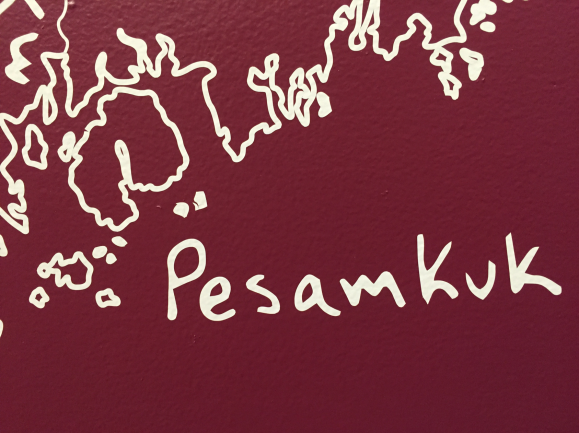
Today, the indigenous communities of Maine are called Wabanaki, but they refer to themselves as Ckuwaponahkiyik, which means “people from the land where the sun rises” and is also the root of the word Wabanaki. According to tribal records, there are 8587 Wabanaki people: 1240 members of the Aroostik Band of Micmac; 1700 members of the Houlton Band of Maliseet; 3369 members of the Passamaquody Nation; and 2,278 members of the Penobscot Nation. I want to acknowledge their presence here today, but want to make this acknowledgement being fully aware of continual violations of water, territorial rights, and sacred sites in the Wabanaki homeland and to work, if called upon and as needed, to help the Wabanaki address those issues.
In my eyes, one of the best ways to understand, respect, and pay tribute to the people who lived here is, first, to press your mind and stretch your understanding of native peoples, of indigeneity, of the very violent, difficult history of the Wabanaki, but, second, to get outside and know their lands intimately. There’s a portal for doing that right by the Dorr Museum, it leads into the Park and the hundreds of miles of trails and carriage trails. We have an ability to know these lands; we also have a RESPONSE-ability to know them.

Second, this convocation is a place and a time to remember someone.
Les Brewer was one of two founding board members. He died on August 23rd of this year. He was 97. I would like to call for a moment of silence for Les.
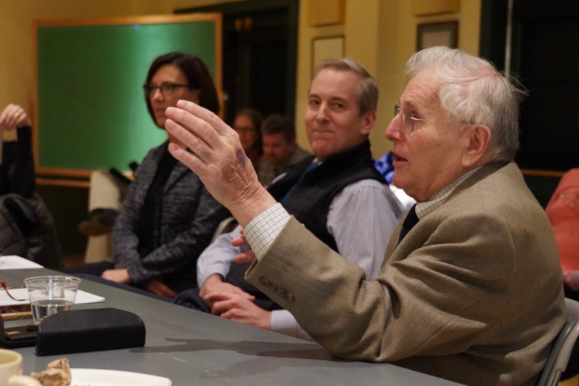
See that portrait on the wall (pointing to picture of Ed Kaelber)? That is Ed Kaelber, our founding president. We will add a portrait of Les, of Father Jim Gower (the other founding trustee), and Anne Peach the first Executive assistant, Chief Operating Officer, and Business Office director. Those four were the original generation; they’re gone and that’s significant.
Third, today I wanted to explore COA a bit and ask “what are those components of what might be called ‘our special sauce'”?
I landed on this idea through two avenues. First, just two weeks ago I had the opportunity to take my own daughter off to college…a life changing experience for both of us. Great school; seems like a great match for Maggie; but, wow, I came back thinking that we definitely take a different tack on education. And that tack is, well, excellent…better…yes that’s a judgement, but if I didn’t think that, there would be something wrong, am I right?
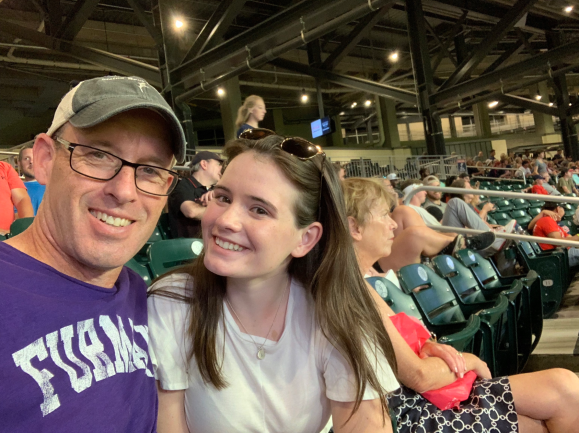
I also have been thinking about the special sauce a lot because of new staff. Convocation last year was on September 5th. I wanted to recognize folks that have joined the staff since then. Kerri Sands—who works with our Sustainable Business Program and food program started on September 4, but I suspect I my have left her off the list last yer; Ivy Enoch joined us as an admissions counselor on September 10th of last year; Don Bareiss joined us on November 30, 2018 as the night watchman; Laura Berry joined us at the Community Energy Center on June 5th; On July 1, John Pergillini came on board as Grounds Director; Sydnie White became an admissions assistant on August 12; Deb DeForest is the new executive assistant to the president and started that role on August 26; and on September 1, Blake Cass became the assistant director of the writing center and Maureen Harrigan started as our new Dean of Administration. WELCOME EVERYONE. Consider this a primer on those intangibles that you just kind of need to experience to understand.
OK, are you ready for “The Top 22 Examples of How COA Takes a Different (read, better) Approach to Higher Education?” I started with a list of 10, but just couldn’t stop.

#22. We have a different perspective on how we share the campus with others critters; where other crews would have bombed the hell out of the hornet nest, we mark it and politely ask you to mind your step.
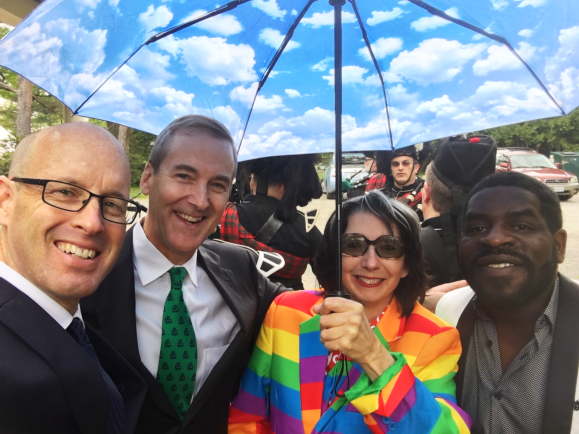
#21. Graduation. We do it really, really well. This was from three years ago; me, then board chairman Will Thorndike; Nancy, who was the Grand Marshall, and the poet Hanif Willis-Abduraqib, who was our commencement speaker. There’s just something very, very special and distinctive about it. Stick around if you can. The chocolate fondu might have something to do with it.

#20. I mentioned Will Thorndike before board chairman, well here he is again on far right. Our approach to athletics is quite different. Where else is the president the coach of the team and the board chairman is the honorary coach? We certainly have a curious approach to athletics and trail running is a real strength of that athletic program. There’s no better place on the East Coast to run trails. We take it very, very seriously.
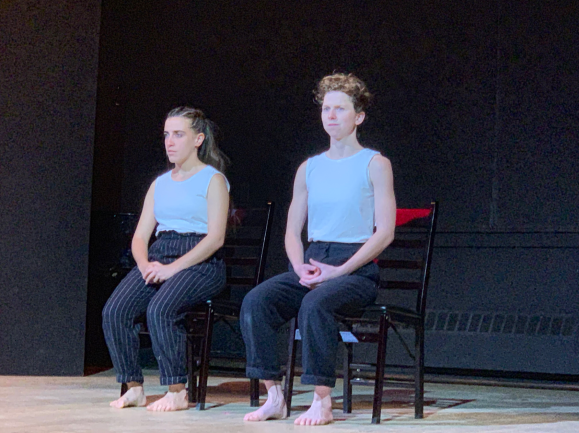
#19. While we’re still on trustees. It is so cool, distinctive, and excellent that the thing our trustees like best about the college: not the endowment, not the fancy buildings, not any sense of prestige. They love our students and their work, as seen in the senior project presentations on the day before graduation. Ask any trustee and they will tell you there’s no better way to understand the college than to experience those talks. A sample from this year would include, Isabel Shaida (above, right) and her dance and movement performance, but also:
Rose McNally, from right here in Bar Harbor, and her, Wound induced polyploidy and integrin-hippo signaling. Rose is a research scientist at the MDI BioLab;
It would include Moni from Lebanon and Body Autonomy and Domestic Violence, An artistic approach for women in Syrian refugee settlements. Moni won the prestigious Thomas J. Watson Fellowship and will be examining domestic violence in four corners of the globe;
And Jolie from Hong Kongwould present A Students’ Perspective on COA Housing Design. Jolie is working for Opal, an architectural firm in Belfast;
There’s Colin from western Maine and his project with the hard-to-memorize title, A Photographic Exploration of Cyanotype and Van Dyke Brown Printing Methods. Colin works with the conservation organization, High Peaks Alliance;
And you’d hear Shivon from San Francisco and her thesis: Alternative versus Traditional Veterinary Care in Southern Chile. Shivon is doing her DVM at UC Davis
Mark your calendars: for students, it’s the Wednesday before graduation.

#18. I think it’s fair to say we take art very seriously and probe it in ways that aren’t always common in a liberal arts setting. For instance, we always ask, “When you say, ‘we must bring the arts and the sciences together, what do you really mean’”? We push and poke on that question in really interesting ways–ways that demonstrate we’re not comfortable with sound bites.
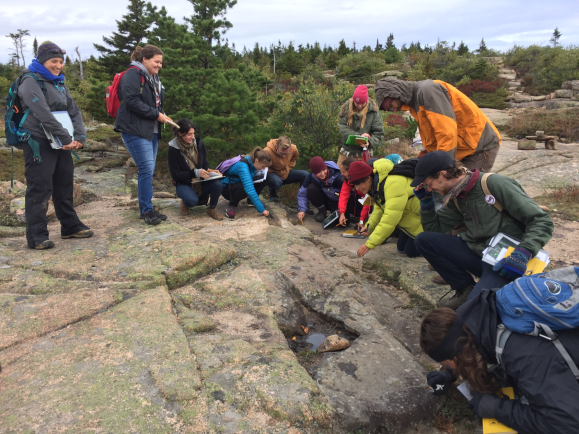
#17. We have a relationship with a unit of the National Park System–Acadia National Park–that is stronger than anywhere else out there. Here’s faculty member Sarah Hall left, and a group of students measuring the directionality of basalt intrusions on the top of Cadillac Mountain.

#16. Plenty of colleges do outing programs for orientation. None do it like we do. None have a Nick Jenei. Have a listen to Nick’s introductory session from last Saturday: “This is what OOPs offers: connection to the landscape, connection with our fellow humans, connections to the earth itself. These are not intellectual pursuits, but profoundly visceral and embodied. OOPs allows us to open up to the natural world around us, with this the world becomes alive and deep truths avail themselves: the connection between all things, the fundamental mystery of being, the eternity in a moment of silence. OOPs allows us to practice the art of being human. Further, these trips are microcosms of the entire human and human ecological experience, they touch on all aspects of life, physical, intellectual, emotional, spiritual. They teach us that whether it be in a small tent, or on a small planet, we truly are all in this together.” Mic drop.

Does anyone know what this is? This is 150 cubic yards of soil from our building project up on the north lawn; eventually it will be sifted and re-incorporated back into the building site where needed. That in of itself is somewhat unique, but just yesterday I learned that Suzanne Morse, faculty member in plant science, will be using Mt. COA as a field site to understand weed diversity, origins, and how weeds get transplanted here, there, and everywhere riding on the coattails of human behavior. The point is: We make the best of strange situations and take all the opportunity to learn from them.

#14. Back on the north lawn: we embrace winter wholeheartedly, academically and recreationally.
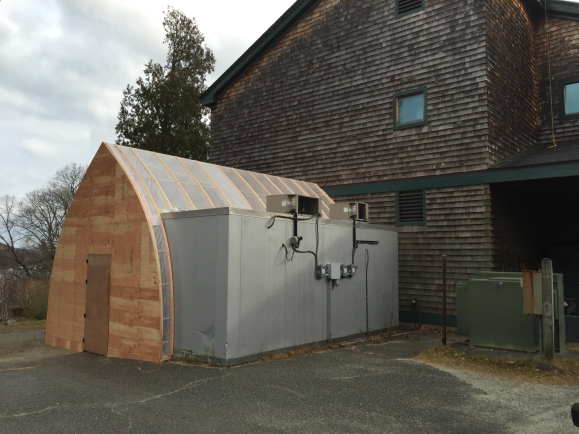
#13. We experiment and improvise. We are scrappier than any other college in the country. On the US News World Report Rankings, we ranked #1 in Scrappiness.
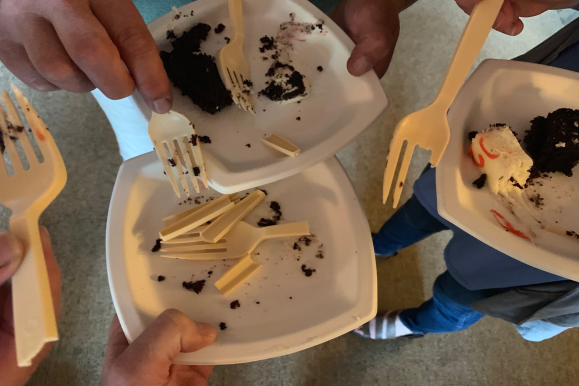
#12. We challenge ourselves with forks–who has not experienced poorly functioning but compostible forks? Kidding aside, we are passionate about discarded resources. We have a long way to go in terms of improvement, but I’m quite certain we’re going to make huge gains. It’s not easy. It’s essential.

#11. We have the unique ability to touch and learn from our history. For instance, we know now that Millard should never sport the mustache solo without a beard (John Mitchell, Les Clark, Millard Dority).

#10. Anyone recognize this guy? Jacques Cousteau. For my generation JC was the marine science hero—the human face of the ocean. And Jacques was great, not taking anything away from the man; but there’s a new face of ocean science.
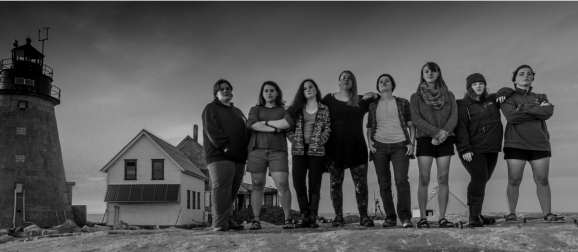
How bad-ass is this photo? I want everyone to know that our campus extends out into the ocean we’re about to swim in. We have a campus 25 miles out at sea at Mt. Desert Rock, pictured here. We also have one on great Duck Island 11 miles off shore. Yes, other colleges have island research stations; none like ours.
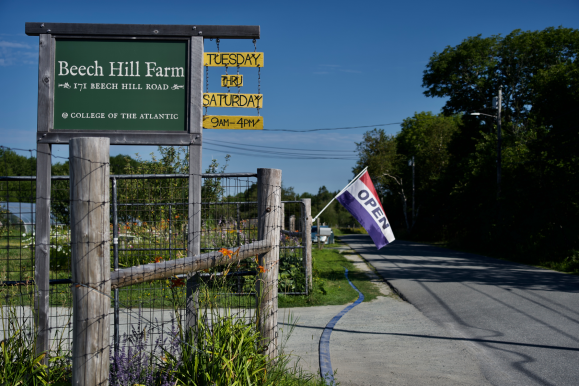
#9. I also want everyone to know that our campus also extends inward, terrestrially. We have two 100+ acre farms. Yes, other colleges have farms, but we have two and they are completely integrated into the curriculum and into our food system. REMINDER: This year Farm Day is being held at Peggy Rockefeller Farms on Monday, September 23rd. Tours will start at 4:00pm and dinner will be served from 5:30-6:30pm. There will be music during dinner.
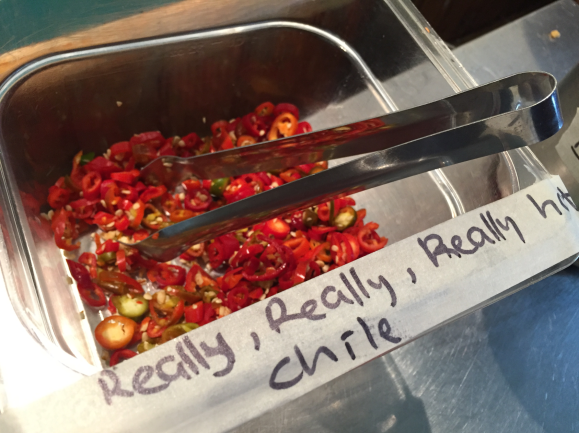
#8. Speaking of farms and food, we take our food really, really seriously.
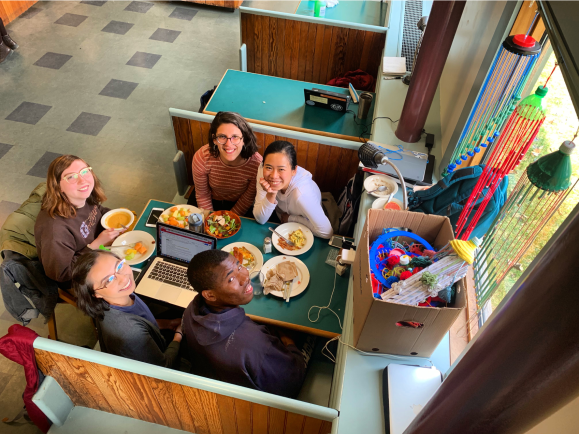
#7. One of the places we take food seriously in TAB. It is the best place to gather and eat, EVER. My wife Karen told me to tone that down, but I couldn’t. We considered momentarily the idea of moving TAB into the new building. It caused wide-spread panic. “Whatever you do, do not mess with Take-a-Break!”
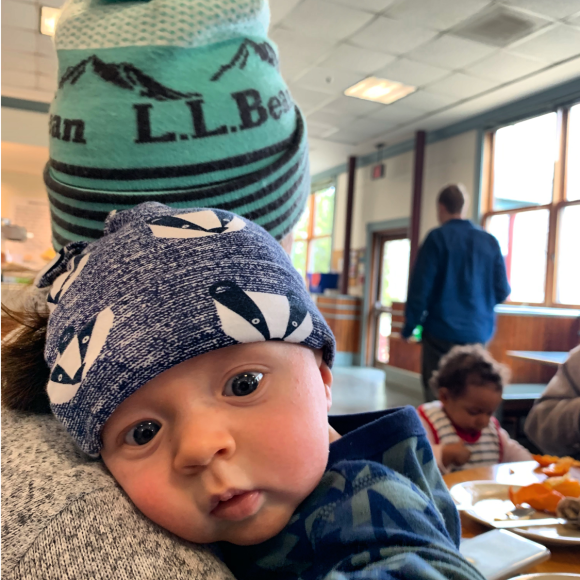
#6. Part of the reason TAB is what it is, is because of kids. Here’s Jack Grizley and you can see Willow in background. You might get to meet Ezra later on. Kids are a part of this campus. We can all use more kids around. There’s so much we can learn from them.

#5. We open worlds up by recognizing that we can learn from everyone. In a transdisciplinary learning environment like ours, you can and should learn physics, and chemistry, and design, and management from stone masons as well as PhD’s, like we did here in the Sunken Garden on campus.

#4. In so doing, our campus becomes a real laboratory. Yes, it is gorgeous and beautiful and should be admired, but it is also worked and studied in and massaged by the hands and minds of students.
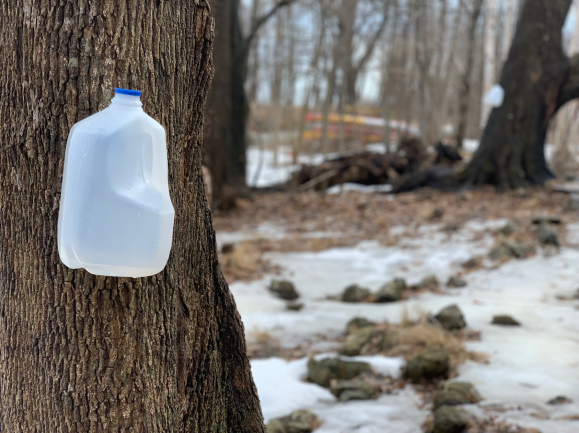
Speaking of the COA-campus-as-laboratory, come spring you’ll see this and become of the COA maple syrup gang.

#3. And speaking of maple sugaring, you’ll find that we like to ferment just about anything we can get our hands on. During last year’s sugaring season, we came across a funky batch and tried to make mead from it. It was a perfect addition to Reuben Hudson’s Chemistry of Food and Drink class.

#2. We were just ranked #3 in terms of most international students—as a percentage of the student body, where we’re at roughly 25%. But that percentage doesn’t do justice to the depth of our globalism. The student community here come from 55 different countries. It took me a long time to put each little diamond on the map. Evii Tong from Kiribati, I apologize, I had to make an honest estimate there out in Micronesia.
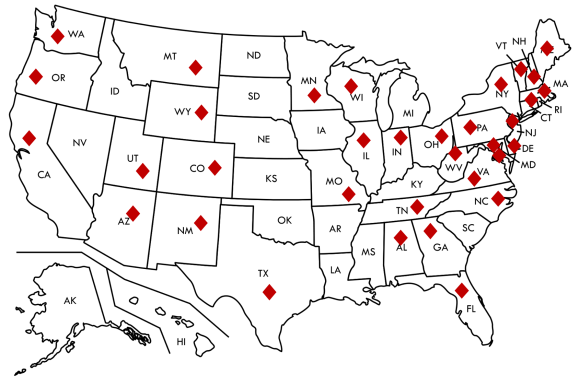
We also come from 37 states across the United States. Put us all together in a small, concentrated, highly-inspired environment and really creative things happen.

#1. Finally, #1. Remember I could have gone forever (I highly suggest you make your own list). The Bar Island Swim. It’s the best convocation day event and is emblematic of what we’re asking you to do here at COA: Challenge and push yourselves intellectually, socially, and physically. Reminder: at 3:30 we will have the safety meeting for the swim here in Gates.
So that’s how I would like to officially open up the academic year. May the year be replete with challenges, with excitement, and with wonder. Let’s hit the water!
